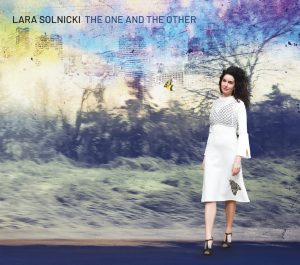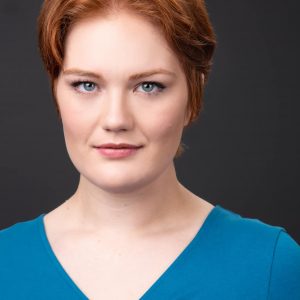Composer, poet, vocalist, visionary. Lara Solnicki, lauded for her “spellbinding voice” and “boldly unique style” (All About Jazz,) demonstrates that she is capable of playing all of these roles simultaneously in her newest album, The One and the Other. Solnicki has been applauded as a “master in her own modern and post-modern poetic mode” and a “poet of the most advanced kind” (A.F. Moritz) and Certainly, the music in the cycle is nothing short of bewitching. The One and the Other is a unique opportunity to experience a song cycle where the text truly belongs to the music and vice versa.
Solnicki describes the cycle as “an exploration into what I perceive as the inherent tension between music and text, where ‘one’ takes the lead with the ‘other ‘allocated to a subordinate role. Sometimes they are engaged in a courtship dance, other times they’re awkwardly at odds with one another.” I believe said tension is the reason that the cycle is so captivating. When I listened to the album, I felt like I was reading an incredible book that I could not put down. I hung onto every note in anticipation of what was to come. Truly, the text and the music are in a relationship and they’re constantly learning to adapt and communicate with one another.
Interplay and mimicry between the vocals and synthesized sounds
The One and the Other was released on March 12, 2021 through record label Outside in Music. The album was recorded and mixed by Jeff Wolpert and produced by Jonathan Goldsmith, an acclaimed Canadian, film composer, who described each song in the cycle as “a miniature movie.” Moreover, the album is divided in two parts. It begins with four songs and finishes with “The One and The Other Suite,” a song cycle in three parts. The suite begins with a prologue (Pass a Glass) and tells the story of a man who is so in love with the idea of love that he drowns in it. The story is told by Lara Solnicki (vocals,) Davide di Renzo (drums), Scott Peterson (bass), Peter Lutek (electro-acoustic clarinet, bassoon, alto saxophone), Hugh Marsh (electric violin), Rob Piltch (guitar), Rich Brown (electric bass), and Jonathan Goldsmith (piano.)

Pass a Glass begins the suite with a minimalistic but poignant vocal line that obscures the presence of any bar lines and suspends metric clarity. Setting the tone for the rest of the suite, Pass a Glass introduces the stylistic assimilation of electronic and acoustic forces. Spoken word is prevalent in the cycle and Solnicki was opportunistic in her choice to have interplay and mimicry between the vocals and synthesized sounds. There is a sense of freedom that triumphs in this movement, reflecting the idea that this movement is ultimately a drinking song. In addition, Solnicki suggests that Pass a Glass contains not only themes of drinking but also a metaphorical, closer examination of the relationship dynamic occurring in the song.
The violin’s pizzicato creates a pointillistic landscape
Awe of the Sea is a Ravel-inspired tone poem that begins with a simplistic piano line that depicts a melancholy scene. The spoken word in this movement is effective, enhancing the instrumentation with colorful words and crisp alliterations. The music resolves to a cinematic section of pizzicato, string music which opens the door to a duet between the violin and the voice. Contrary to the tradition of making violins “sing,” the voice begins to imitate the violin’s pizzicato, creating a pointillistic landscape which begins to replicate the various forms and dispositions of water. The ending can only be described as impressionistic piano over groovy jazz.
Hollow the Need finishes the suite with poise, utilizing the lower register of the voice and offering the listener a sense of completion. In its entirety, the album has coherence through repeated motives and textures. This includes the songs outside of the suite. Solnicki brilliantly connects the album with a thread of ideas and motives. From the first note of Bit Her Sweet Christopher Street which opens the album, Solnicki sets a tone and asserts her unique style and voice.
Bit Her Sweet Christopher Street (Perhaps a play on the words” bitter sweet”) is inspired by Debussy’s “Cinq Poemes de Baudelaire” which is demonstrated through its “fluid rhythms and time signatures governed by the natural speech rhythms” (Moritz.) The song starts in community and trickles into solos and disparate elements. The song is defined by rhythmic playfulness and ambiguity and the influence of rock music is evident in the electric guitar’s scoring.
A definitive reliance on electronic elements
Much like the first song, the second song pays homage to a brilliant composer. Idée Fixe was inspired by J.S. Bach’s signature style. At the same time, the jazz influence is evident through the use of scat. Moreover, Solnicki’s use of counterpoint is simultaneously traditional and eclectic. The polyphonic waxing and waning of layered voices create a texture that can only be described as a mix of phase music and fugue. When the saxophone enters, the piece feels reminiscent of musicians practicing in adjacent practice rooms and emulating one another’s melodies and timbres. It comes together beautifully as the instruments become unified, ending the piece with stability and finality.
The Embrace is a moment of reflection for the listener. The detached vocal line and moments of silence give the audience time to process the journey they have been on. It is followed by Furling Leaf Retrocede which was “largely improvised”(Moritz) by the players. As Lara takes her audience on a poetic journey, the instruments explode in a cacophony of independent melodies and the sonorities become increasingly crowded. There is a definitive reliance on electronic elements in this song as the speaker journeys to and from the laundromat in a noisy city.
Lara Solnicki is doing amazing work to advance and expand the idea of what music can be. By incorporating elements of jazz, electronic music, rock, spoken work, and classical music, she is redefining our concept of genre and stretching outside the confines of tradition for traditions sake.

Michaela Wright has recently received her Master of Music in Opera Performance and Literature from The University of Illinois at Urbana-Champaign where she studied privately with Jerold Siena. Since her graduation last Spring, she has signed on as a company artist with Moon River Opera, started studying privately with Michelle DeYoung, and has created content for Opera on Tap Maine, Protestra, Moon River Opera, Cabaret Your Way, and is working cross-continentally with “The Arc Project.” Her recent credits include The Fox in Janácek’s Cunning Little Vixen (The Krannert Center for the Performing Arts,) Orfeo in Gluck’s Orfeo Ed Euridice (The Armory Free Theatre,) Bianca in Britten’s The Rape of Lucretia (The Krannert Center,) and Mrs. Segstrom in A Little Night Music (The Krannert Center.) Recently, Wright has also been seen in La Boheme (directed by Nathan Gunn and Sarah Wigley,) Take Flight (a 29-hour reading of the new musical directed by Broadway lyricist, Richard Maltby,) and in a workshop presentation of the new opera, Sensorium Ex (Composed by Paola Prestini and produced by The Beth Morrison Project.) She is traveling to the Czech Republic this August to perform with Opernfest Prague.
]]>